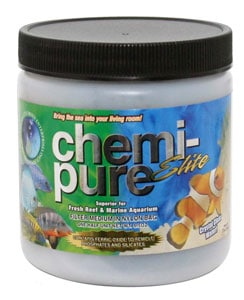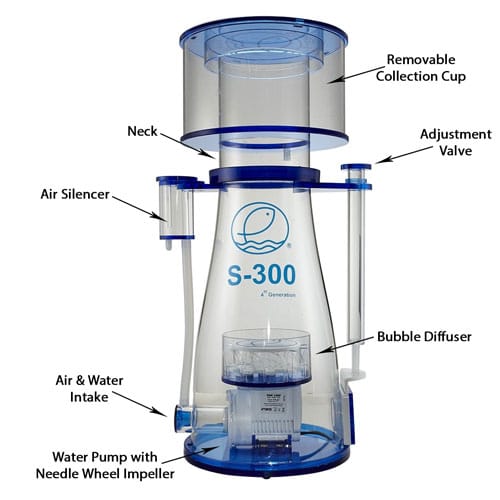Many newcomers to the aquarium hobby have the question of whether the aquarium filter needs to be on all the time and it is a very valid question, but with one simple answer, Yes. But, perhaps the filter is too noisy, or there is concern about the electricity consumption.
Aquarium filters need to be running all day, every day. They provide mechanical, chemical & biological filtration as well as oxygenation of the water. Turned off, decaying food & fish waste will build causing Ammonia, Nitrite & Nitrate levels to rise which are all toxic to aquatic livestock.
Providing the cleanest and healthiest environment for your new aquatic family members is paramount so let’s go and look at why aquarium filters need to run all the time.
Why Do Aquarium Filters Need to Be On All The Time?
Your fish, shrimp, crabs, plants, and coral living in the aquarium are living and because of that they are consuming food and excreting 24/7. The filter/s we install on our aquariums are there to remove and convert the waste they produce to prevent it from becoming toxic to the livestock.
Because the waste being produced is happening 24/7, the aquarium filter/s need to be working 24/7.
When the filter on an aquarium is not running, the toxicity levels in the water begin to rise. The longer the filter is turned off, the higher these levels will rise. Even a small rise of ammonia will instantly kill your livestock!
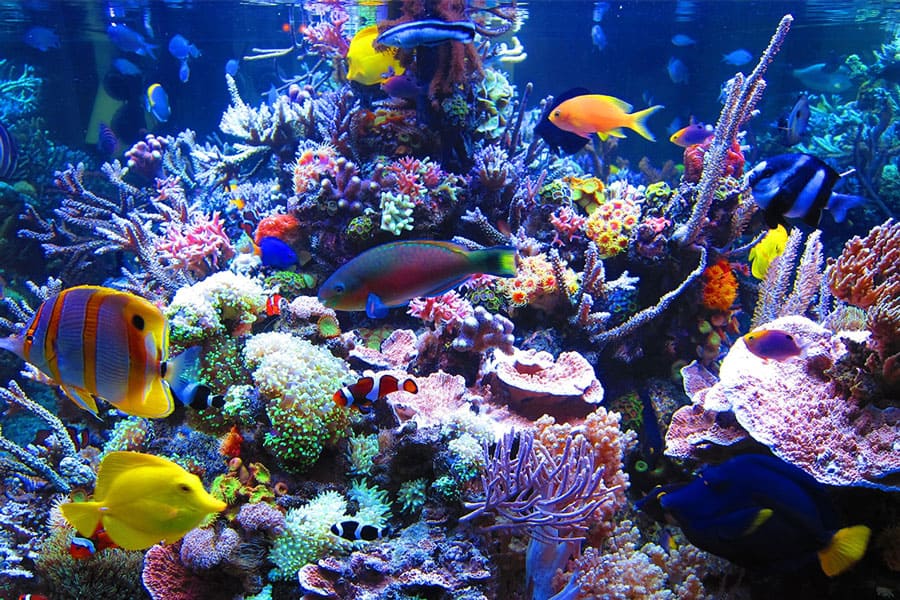
Aquarium filters work in 3 main areas, with a 4th benefit:
- Mechanical Filtration
- Chemical Filtration
- Biological Filtration
- Aeration
The Aquarium Filters Role in Mechanical Filtration
Mechanical filtration refers to the physical removal of the debris & detritus in an aquarium. Debris & Detritus can be uneaten food, biological waste from the livestock, or decaying organic matter from dead animals, plants, coral, and any other organic sources.
For any stretch of time that the filter is off, debris starts accumulating in the tank. As this debris and detritus accumulate they begin to decay. As they decay they release ammonia into the water. Ammonia is highly toxic to your livestock and the only way to prevent this rising is to physically remove the waste material yourself, do a water change, or let the filter do it.
The most common ways that filters mechanically remove waste material is by using filter socks and sponges to physically trap suspended particles in the water. As the owner, it is your responsibility to remove and clean/replace the filter media, thus removing the trapped waste matter before it has chance to breakdown and releases ammonia.
This is why weekly filter cleaning is recommended!
Beginners Tip:
NEVER wash your filter media under a running tap. This will kill any beneficial nitrifying bacteria living within it. When doing a water change, fill a bucket with old tank water, then thoroughly rinse the filter media in that bucket, then dispose of that water. This will keep your bacteria alive!
This is especially important in small aquariums with small filters!
The Aquarium Filters Role in Chemical Filtration
If your filter has media in it like Activated Carbon, Purigen, Chemi-pure, Bio Pellets, Granular Ferric Oxide (GFO), or something similar then this is the chemical filtration part of keeping your aquarium water clean.
Chemical filtration helps to absorb pollutants from the water. Odors, heavy metals, nitrates, ammonia, and airborne pollutants entering the tank are all processed by these chemical filter materials.
When the filter system is turned off the filtering of these pollutants stops. Although the speed at which your aquarium water will foul is a lot slower than the mechanical filtration part, it will still begin to decrease in quality which will begin to affect your livestock over time.
Chemical filter media can be in the form of chemically impregnated sponges, granules in a mesh/cloth bag, or for large aquariums, dedicated media reactors that have tank water pumped through them.
The Aquarium Filters Role Biological Filtration
Biological filtration is the use of naturally occurring bacteria that consume and convert ammonia, nitrite, and nitrate in the aquarium water. When you hear ‘Nitrogen Cycle’ or ‘Aquarium Cycle’, this is the biological bacteria establishing and multiplying in your aquarium and filter.
Here’s a super-fast review of the nitrogen cycle: Dangerous ammonia is produced by decaying organic matter and fish waste in the aquarium. Beneficial nitrifying bacteria called Nitrosomonas Bacteria consume and convert this ammonia into less toxic nitrite.
Nitrite is then consumed and converted to nitrate by the second strain of nitrifying bacteria called Nitrobacter Bacteria. Nitrate is the least toxic pollutant in your aquarium water.
Nitrate is then controlled by regular water changes. Without the water changes, the nitrate will accumulate which will become toxic to your livestock if at high levels.
These beneficial bacteria, also known as nitrifying bacteria, don’t have to be added to your aquarium they will just naturally grow in it. Although most aquarists will jumpstart their nitrogen cycle by adding a starter culture when first setting up the aquarium.
Dr. Tims One And Only Live Nitrifying Bacteria cultures are one of the most popular. They are available in both Freshwater & Saltwater versions:
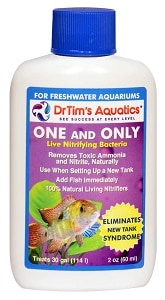
Here at Amazon.com
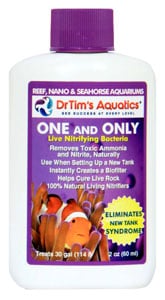
Here at Amazon.com
These beneficial bacteria can be found all over your aquarium. In the substrate, the rocks, and in the filter media. The more surface area a filter media has, the more beneficial bacteria it can house.
As the aquarium water passes through the filter media, the beneficial bacteria do their important work of getting rid of ammonia and nitrites. Should you turn off your filter this process is halted. Biological filtration doesn’t come to a dead stop since the tank does have beneficial bacteria in the substrate and on the rocks, but the level of biological filtration will be diminished.
While biological filtration is reduced, the rate of ammonia and nitrite production continues as before. This imbalance will result in a more toxic environment in your tank as these toxins increase because water is no longer being passed through the filter and the bacteria housed within it.
The longer the filter remains off, the higher the levels of ammonia, nitrite, and nitrate will become.
The Aquarium Filters Role in Aeration
As I mentioned earlier, the added benefit that most aquarium filters add is aeration. Aeration simply means injecting oxygen into a material. In the case of aquariums, this means oxygenating the water.
The filter oxygenates the water as it sucks or pumps it through the filter system. As filter/s remove water from the tank, push it through the filter media, and returns it back to the tank, the water naturally churns. This pulls oxygen into the water and releases gases like nitrogen and carbon dioxide.
As the water is returned back to the tank it causes surface agitation which further improves gas exchange of the entire tank volume. The returning water also creates a current in the tank to help bring up water from the lower levels and towards the surface. This improves gas exchange and keeps detritus suspended in the water for removal by the mechanical part of the filter.
Oxygenated water is vital to the livestock in your aquarium. Fish, invertebrates, plants, corals, and also beneficial bacteria require a constant supply of oxygen to survive. Even if you have separate aeration equipment, like an air bubbler on a freshwater aquarium, turning off the filter reduces the aeration levels of the tank.
Is Aquarium Filter Electricity Consumption a Concern?
If the reason you want to turn off your filter is because you want to save electricity, it is worthwhile to take a look at the electricity consumption for a typical aquarium setup.
A small aquarium of, say, 50 gallons, would consume 450 kWh of electricity a year. This is for the entire aquarium setup including the filter, the lights, and the heater. If you look at just the filter alone, this counts for only around 150kWh each year!
The Average Electricity Consumption of an American Household is 11,000 kWh Per Year.
Source: U.S. Energy Information Administration
This means that running a filter for the entire year comprises 1.4% of the total average electricity consumption of your home!
For Example:
To do the math yourself here are the equations:
Rate Examples:
California Electrical Rate Average 2019 = 19.90 ¢/kWh
Florida Electrical Rate Average 2019 = 11.37 ¢/kWh
Selected Filter: Fluval 307 Canister Filter (Amazon.com)
Pump Power = 16 Watts.
It runs 24 hours Per Day.
Example Electricity Rate = 13.45 ¢/kWh.
16 Watts/1000 = 0.016 kWh – KiloWatt Hours (How many 1000 watts per hour)
| 0.016kWh x 13.45¢ | = 0.22¢ to run each hour |
| 0.22¢ x 24 hours | = 5.28¢ to run each day |
| 5.28¢ x 7 days | = 36.96¢ to run each week |
| 39.96¢ x 4 weeks | = $1.48 to run each month |
| $1.48 x 12 months | = $17.76 to run each year |
Therefore, the electricity consumption of your filter is negligible and you should not worry about keeping your filter on all the time!
How To Make An Aquarium Filter Quiet?
Another reason that you might want to turn off your filter is that the sound of it can be disturbing, especially if your aquarium is located in a bedroom. Honestly, I had an aquarium in my bedroom for my entire teenage life, and although they can have a hum or noise to them it is something you will soon become accustomed to.
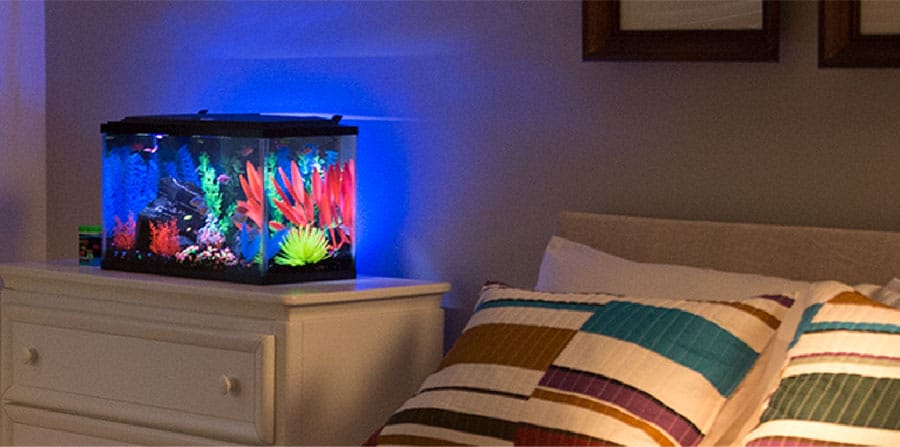
In fact, whenever there was a power outage the stillness sounded and felt very strange! But, if the aquarium is bothering you here are a few things you can do to try and lower its audible footprint:
- Ensure there is no debris stuck in the filter making it louder than it should be. Regular maintenance and cleaning will ensure all parts get cleaned and inspected for wear. A worn impeller shaft on a second-hand pump can soon vibrate very loudly.
- Maybe the water return system of your filter is through a waterfall or an external hose splashing the water into the tank. In cases like this, submerging the return nozzle could help solve the issue. If you have an external filter that uses a waterfall to return the water then raising the water level in the aquarium so the fall is not as far will help reduce noise.
- Another cause of filter noise is the water flow rate set to maximum. If your filter has a flow rate control mechanism or an adjustable pump speed, the solution could be as simple as selecting a lower flow rate setting.
- When buying a new filter be sure to read the reviews regarding its noise level. Try it out in the store, if able, and compare it with other models. Ask the store owner for their advice on which filter to choose if its noise output is of concern.
- Having filters in the base of the aquarium stand can cause the stand to act as an amplifier. Try moving the filter outside of the stand or placing the filter on a silicone mat or mouse mat. If the filter sits on the side of the aquarium and is vibrating, try placing some rubber feet or a piece of rubber between the filter and the tank.
What Kinds of Aquarium Filters Can You Use?
If you are unhappy with your current filter and are considering switching, let’s talk about the different kinds of aquarium filters available on the market.
Protein Skimmers
Protein Skimmers are used solely on saltwater aquariums. They are the backbone of mechanical aquarium filtration and in my opinion, no reef tank should be run without one.
Protein skimmers work by using bubbles to physically remove proteins from the water. If you’ve ever walked on the beach and noticed the foam gathering near the shore and how it contains some ocean gunk, protein skimmers work along the same lines.
They mix water and microscopic air bubbles to create a massive surface area that proteins and other waste materials within the water to stick to. As each bubble rises it transports the waste to the neck of the protein skimmer and then the bubble bursts, releasing the waste that was stuck to it. This waste material is collected in a cup and disposed of by the owner.
For more detailed information on Protein Skimmers check out my article:
What Is A Protein Skimmer And Do I Need One?
HOB Filters
HOB means Hang-On-Back and this is exactly how these filters are located on an aquarium. Also known as Power filters, they just hang on the top rim of the tank and can be situated on any side which best suits you.
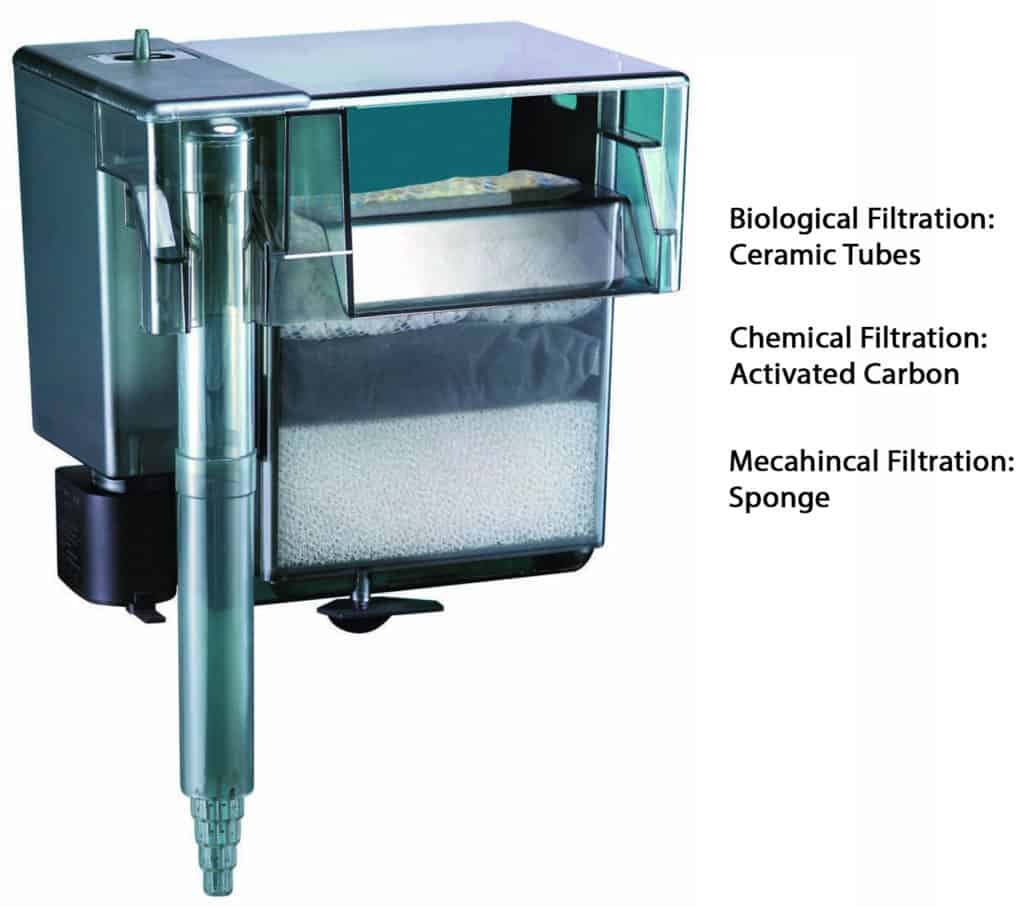
HOB filters are a great choice if you want simple, inexpensive, and easy-to-maintain filters. Maintenance is pretty much a matter of taking out the filter media from the easy-to-access compartment and cleaning or putting in a new one.
HOB filters are compact, with the pump and filter media in one unit which sits outside of the aquarium, and a submerged tube or hose that extracts water from the tank. The water passes up through the filter media, and goes back to the tank through a chute. The chute produces a laminar waterfall effect that helps aerate the water and reduce noise.
HOB filters are recommended for smaller tanks and may be used to work in tandem with another HOB filter in bigger tanks.
For more detailed information on HOB/Power Filters check out my article:
Can You Use A HOB Filter For A Saltwater Tank?
Canister Filters
Canister filters are an ideal filter for those who want silent filters since they are renowned for being super quiet. They are also a great choice if you want a hidden filter since canister filters can be stored out of sight – typically below the tank in the stand.
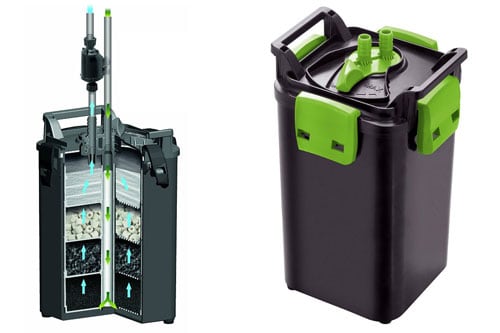
Canister filters siphon water from the tank via a hose and pass it through several stages of filter media before returning it to the tank via a return nozzle or spraybar. Canister filters are great for freshwater aquariums and have been used on smaller saltwater aquariums, but you must make sure you clean them regularly to prevent the buildup of debris and detritus in the base of the canister.
The multiple media chambers allow you to select various types of filter media to achieve the filtration you require. Be sure to get a self-priming filter to ensure it starts and regains suction after a power outage.
For more detailed information on Canister Filters check out my article:
Can You Use A Canister Filter For A Reef Aquarium?
To Finish
Aquarium filters should be operating all the time since they contribute four key things to an aquarium: Mechanical Filtration, Chemical Filtration Biological filtration, and Aeration. These four things must be present in an aquarium 24/7 to combat the constant production of waste material by your livestock.
There are many great filters out there in every configuration you could need for an aquarium, so finding one is a simple task. By reading the manufacturer’s descriptions, asking other aquarium owners for recommendations, and reading product reviews you will have no trouble selecting the perfect filter for your setup and allow it to run 24/7.
Further Reading
To further help you in your aquarium research, I highly recommend these other articles:

